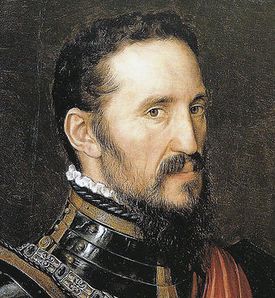Gonzalo Vázquez Luján
Adelantado Commander Gonzalo Vázquez Luján | |
|---|---|
 Posthumous depiction of Vázquez Luján (1650). | |
| 1st Captain General of San Juan | |
| In office 13 July 1431 – c. 1435 | |
| Monarch | Miguel III |
| Preceded by | Position established |
| Succeeded by | Armando Rivera Obregón |
| Personal details | |
| Born | Gonzalo Francisco Vázquez y Luján 22 September 1393 Denshire, Jakiz, Creeperopolis |
| Died | Presumed 1435 (aged 41–42) Presumed modern-day Itse Ulagohisdi, Sequoyah |
| Cause of death | Unknown |
| Spouse(s) | Clara Valladares Noroña (m. 1434; his death 1435) |
| Children | José Vázquez Valladares Melina Vázquez Valladares |
| Profession | Military |
| Known for | Creeperian expedition across Sequoyah |
| Military service | |
| Allegiance | |
| Branch/service | |
| Years of service | 1411–1435 |
| Rank | Commander |
| Commands | San Juan garrison |
Gonzalo Francisco Vázquez y Luján (22 September 1393 – c. 1435) was a Creeperian conquistador and military officer who served as the first Captain General of San Juan and commanded the Creeperian expedition across Sequoyah in both 1433 and 1435. He disappeared, along with his 300 men, during his second expedition across Sequoyah in 1435. He founded Mission San Juan and the Sequoyan city of San Juan.
Early life
Gonzalo Francisco Vázquez y Luján was born on 22 September 1393 in Denshire, Jakiz, Creeperopolis. His father was Jesús Fernando Vázquez y Santos and his mother was Marcela Fátima Luján y Núñez. He was the couple's eldest child and the older brother of Miguel, María, Rosa, Emmanuel, Pedro, and Alexandra. Prior to 1430, little is known about his personal and military life.
Expeditions in Sequoyah
In 1430, Vázquez Luján was commissioned by King Miguel III to lead an expedition of Creeperian soldiers into modern-day Sequoyah with the intention of expanding Creeperian colonial ambitions south. His soldiers landed in modern-day Eastern Sequoyah in 1431, and there, he founded the Captaincy General of San Juan on 13 July 1431. He also established the San Juan Mission and the city of San Juan. Domingo Viteri Ungo was installed as the first pastor of the mission by Pope Eugenio IV.

In 1433, he commanded an expedition west with the objective of conquering land for Creeperopolis and to convert the Natives living there to Creeperian Catholicism. The expedition consisted of 100 soldiers and missionaries. His expedition traveled through Navaja and Caprican territory, and eventually reached the Promethian Canyon in modern-day Itse Ulagohisdi. After crossing the canyon, the Creeperans met with Caprican Natives, but during their meeting, a battle ensued and 53 Creeperans were killed. After the bloody encounter, the expedition returned to San Juan.
In 1434, Vázquez Luján fathered a pair of illegitimate twins from a Creeperian woman named Clara Xihomara Valladares y Noroña in San Juan. They were named José and Melina. His fathering of illegitimate children caused controversy among the clergy and his soldiers and he married Valladares Noroña in an effort to make his children legitimate within the Catholic Church.
In 1435, Vázquez Luján led another expedition of 300 men across Sequoyah with the goal of reaching the western Southern Ocean and to exert revenge against the Capricans which attacked the first expedition. The last report from the expedition reached San Juan in July of 1435, confirming that the expedition had reached the Promethian Canyon. San Juan received no further communications from the expedition and sent out a search party of 100 men to search for the expedition. The expedition was never found and the search party returned home.
Legacy
To this day, the fate of Vázquez Luján's expedition is unknown, although modern historians hypothesize that it was destroyed by Caprican attacks. It has since been known as "The Lost Expedition." Vázquez Luján is considered an important figure in the history of Eastern Sequoyah.





